

Memory in the Brain [Interactive] Although most people think of memory as a vault for storing information, it is more like a seamstress who stitches together logical threads into scenes that make sense.
![Memory in the Brain [Interactive]](http://cdn.pearltrees.com/s/pic/th/memory-the-brain-interactive-82305932)
In this view, a good memory is therefore not one that holds lots of data but that can deftly separate what is useful from what could distract or upset you. Getting rid of what is not necessary—forgetting—is thus an important part of memory and of thought. It is also critical to emotional wellbeing. Revisiting bad memories is hardly a formula for happiness, after all. (For more on memory and forgetting, see Scientific American Mind’s special report on memory in January/February 2012.) To learn more about memory and the power of forgetting, see the January 2012 Scientific American Mind.
More to Explore8 Ways To Forget Your TroublesLet It GoA Feeling for the PastTrying to ForgetTotaling Recall10 Novels That Will Sharpen Your Mind [Interactive] Researchers Map Brain Regions Linked to Intelligence. FRIDAY, April 13 (HealthDay News) -- The physical architecture of intelligence in the brain has been mapped by scientists who used brain injury patients to conduct their research.
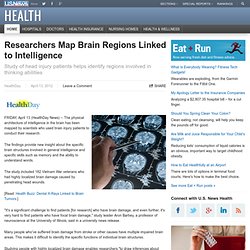
The findings provide new insight about the specific brain structures involved in general intelligence and specific skills such as memory and the ability to understand words. The study included 182 Vietnam War veterans who had highly localized brain damage caused by penetrating head wounds. [Read: Health Buzz: Dental X-Rays Linked to Brain Tumors.] "It's a significant challenge to find patients [for research] who have brain damage, and even further, it's very hard to find patients who have focal brain damage," study leader Aron Barbey, a professor of neuroscience at the University of Illinois, said in a university news release. Many people who've suffered brain damage from stroke or other causes have multiple impaired brain areas. [Read: Study Suggests Vaccine May Help Kids With Brain Cancer.] More information. The Involvement of a Na - and Cl–-Dependent Transporter in the Brain Uptake.
†Drug Delivery, Disposition and Dynamics and ‡Centre for Drug Candidate Optimisation, Monash Institute of Pharmaceutical Sciences, Monash University, Parkville, Victoria, Australia § Department of Medicine, Weill Medical College of Cornell University, New York, New York, United States.

Dopamine and the Diseased Brain. Abstract: Dysfunction of central dopaminergic neurotransmission has been implicated in a series of neuropsychiatric disorders, including Tourettes syndrome, schizophrenia, and drug and alcohol dependence.
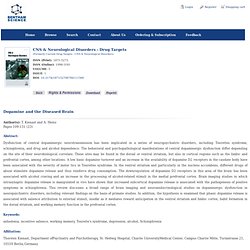
The behavioral and psychopathological manifestations of central dopaminergic dysfunction differ depending on the site of their neurobiological correlate. These sites may be found in the dorsal or ventral striatum, but also in cortical regions such as the limbic and prefrontal cortex, among other locations. A low basic dopamine turnover and an increase in the availability of dopamine D2 receptors in the caudate body have been associated with the severity of motor tics in Tourettes syndrome. Brain Basics. Introduction Watch the Brain Basics video Welcome.
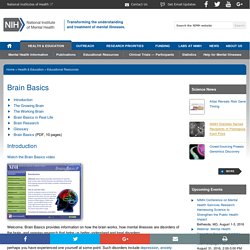
Biologists discover an unusual hallmark of aging in neurons. As we age, neurons in our brains can become damaged by free radicals.

MIT biologists have now discovered that this type of damage, known as oxidative stress, produces an unusual pileup of short snippets of RNA in some neurons. This RNA buildup, which the researchers believe may be a marker of neurodegenerative diseases, can reduce protein production. Study links brain anatomy, academic achievement, and family income. Many years of research have shown that for students from lower-income families, standardized test scores and other measures of academic success tend to lag behind those of wealthier students.

A new study led by researchers at MIT and Harvard University offers another dimension to this so-called “achievement gap”: After imaging the brains of high- and low-income students, they found that the higher-income students had thicker brain cortex in areas associated with visual perception and knowledge accumulation. Furthermore, these differences also correlated with one measure of academic achievement — performance on standardized tests. “Just as you would expect, there’s a real cost to not living in a supportive environment. ToxicPsychiatry - Home. Max Planck Neuroscience on Nautilus. Brain cost-efficiency linked to family genes. Some brains are wired more efficiently than others, and new research has shown that 60% of the differences can be explained by genetic factors.
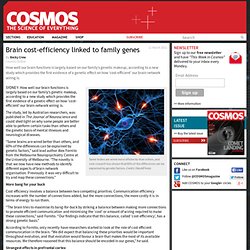
Credit: iStockPhoto SYDNEY: How well our brain functions is largely based on our family’s genetic makeup, according to a new study which provides the first evidence of a genetic effect on how ‘cost-efficient’ our brain network wiring is. The study, led by Australian researchers, was published in The Journal of Neuroscience and could shed light on why some people are better able to perform certain tasks than others and the genetic basis of mental illnesses and neurological diseases.
“Some brains are wired better than others, and 60% of the differences can be explained by genetic factors,” said lead author Alex Fornito from the Melbourne Neuropsychiatry Centre at the University of Melbourne. “The novelty is that we now have new methods to identify different aspects of brain network organisation. More bang for your buck.
Brains Prune. Brain Twists. Human brain. The human brain has the same general structure as the brains of other mammals, but has a more developed cortex than any other.
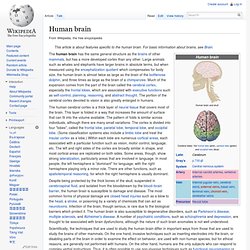
Large animals such as whales and elephants have larger brains in absolute terms, but when measured using the encephalization quotient which compensates for body size, the human brain is almost twice as large as the brain of the bottlenose dolphin, and three times as large as the brain of a chimpanzee. Much of the expansion comes from the part of the brain called the cerebral cortex, especially the frontal lobes, which are associated with executive functions such as self-control, planning, reasoning, and abstract thought.
The portion of the cerebral cortex devoted to vision is also greatly enlarged in humans. The human cerebral cortex is a thick layer of neural tissue that covers most of the brain. This layer is folded in a way that increases the amount of surface that can fit into the volume available. Structure[edit] Human brain viewed from below Four lobes[edit] ViewPort. How the brain works. BRAIN POWER: From Neurons to Networks. Dr. Dan Siegel - Explains Mirror Neurons in Depth. Artificially Intelligent. Divergence. Memento. Thought Patterns.
Genomic Insights. MEDICA. Pathways. Pay to view. NeuroLabNet. Brain. Brain. BRAIN. Out-of-the-box thoughts.